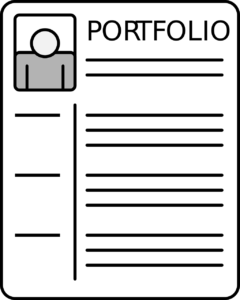If you are an artist or developer looking to showcase your skills and reach a wide audience you might consider setting up a website to act as your own online CV which tells potential employers or clients what you are capable of achieving. This article looks at why and how to create an online portfolio for beginners.
Why Should I Create an Online Portfolio?
First you need to think about what you wish to achieve. You might be a new student looking to share your progress to far in order to attract a potential job opportunity after college, and if you can’t show anyone what you’re good at, it’s not as easy to convince them that you’re the right person for the job. An interview by itself just isn’t enough, you need to show some proof.
Or you might be a fully fledged professional in your creative role for a few years now, simply wanting to look for potential clients to hire you for your craft. An online portfolio can help attract new business by showing others your best work and letting them see if your art style is what they are looking for. Developers are not excluded here. While it’s easier to see an artist’s skill by looking at visual media like pictures and videos uploaded online, a developer can still present the world with an online CV that explains what they have done or are able to develop for companies around the world.
When Should I Start it?
As soon as you have finished a few projects or examples of work, you should think about sharing it. Keep in mind that the better examples you have, the more impressive your portfolio will look. You don’t need to be a master of your craft before creating a CV when you search for a job, as learning is a lifelong process and no one expects you to be at the advanced level when you’re just starting out. It’s important not to lie about what stage you’re at, show clearly what level of learning you are at and what you can create so far so you don’t waste your time or others.
It’s really important to share your best work as you complete it and show off your capabilities. Even if you are right at the start of your journey, you can look at this as a way to push yourself to create better and better projects and replace the older content on your portfolio with newer and better things. It’s an ongoing evolution of your best work. Don’t be afraid to show your work if you’re a student, everybody has to start somewhere after all and if you put your work out there you are making a connection with the world in a wonderful way that can grow your career.

How Much Time Should I Spend on This?
How much time would you spend typing out a CV to apply for a job? Try to think of the time spent as an investment into getting great offers and opportunities. You could spend 10 minutes posting 1 example of your work on a social media app, and perhaps get a few or many visitors interested, but that 1 example might not be the one that makes a connection with a client that could have happened if you’d posted something that peaked their interested instead. An online portfolio should clearly present itself to the reader/viewer as your best work, and it should also be clear what skills you have as well as show what kind of projects you can handle. When you first create your portfolio, spend some hours choosing your best work, and what you wish to share. Then every now and then look back and see if you feel the need to replace any of the entries, or update your list of skills so that it’s relevant to the viewer.
What Stuff Should I Share with Others?
This is up to you. What would you like to show off and what are you allowed to show people? If you’ve done some work for a client who does not want to you display that work online you need to respect that, so it’s really something you need to consider when you are thinking about your desired outcome from this. In general, show your best work that you think people want to see.
In addition, make sure to provide engaging descriptions that summarizes processes and tools used to give them a better understanding of your capabilities. And don’t forget to add contact information somewhere that’s easy to find should they want to offer you work.
How Much Will This Cost?
You can share work for free or you can pay for it, it all depends on the format you want people to view your work on.
Social media is a great way to share post after post of your creations but it’s not easy to show all your work to the viewer unless they look for it. Including links to your portfolio online can be helpful for anyone wanting to see what else you have done. You might want to share your work across a few platforms both free and paid to reach a wide audience. A large company looking to hire an artist may or may not stumble across your website by itself or across any one Instagram post by itself for example. If you are willing to pay for a website then it’s better to have both, and bring visitors for free from your online posts to your website so they can get a complete feel of your work and what you can do. It also looks quite professional having your own website, but if you feel it’s an unnecessary cost then simply don’t bother, social media can reach a lot of people by itself.
What Tools Can I Use to Create an Online Portfolio?
Having a website these days is fairly easy, you need to get a domain name and pay to host a website online. Fozzy is a cheap hosting provider where you can do both, they sell many domains under $20 and let you run a website for less than $5/month where you can install a free app like WordPress to create a nice website and use it to post your work.
There are many themes available for free which can be customized to your desired appearance but at the end of the day whatever look the website theme has, your uploaded portfolio should outshine it and attract clients or companies, or whoever you want to look at your work.
However you decide to showcase your best skills, don’t hesitate to put it out there and attract potential opportunities that can grow your career in ways you never thought possible.

